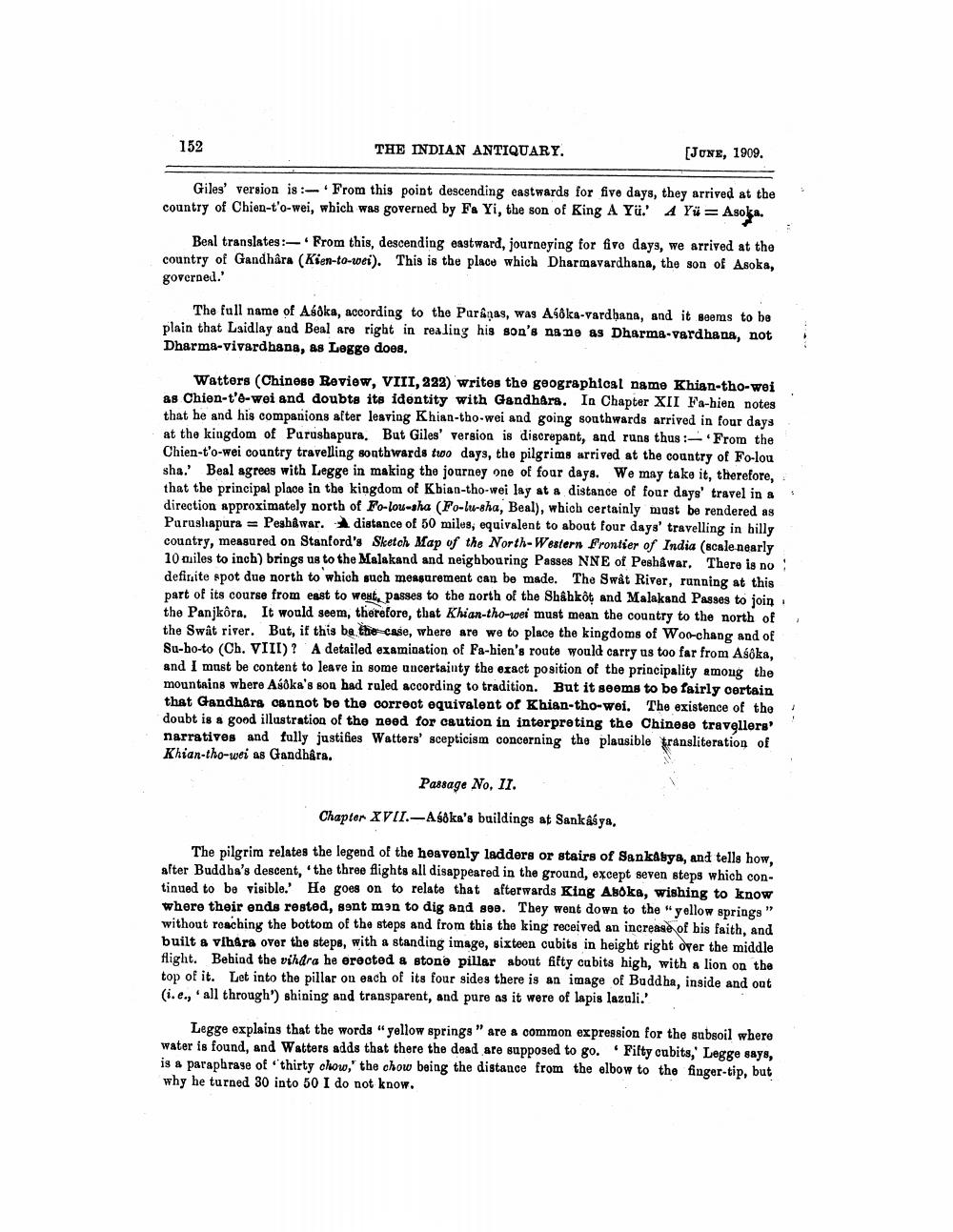________________
152
THE INDIAN ANTIQUARY.
(June, 1909.
Giles' version is :- From this point descending eastwards for five days, they arrived at the country of Chien-t'o-wei, which was governed by Fa Yi, the son of King A Yü. A Yü= Asoka.
Beal translates:- From this, descending eastward, journeying for five days, we arrived at the country of Gandhara (Kien-to-wei). This is the place which Dharmavardhana, the son of Asoka, governed.'
The full name of Asoka, according to the Paranas, was As8ka-vardhana, and it seems to be plain that Laidlay and Beal are right in realing his son's nane as Dharma-vardhana, not Dharma-vivardhana, as Legge does.
:
Watters (Chinoso Review, VIII, 322) writes the geographiost name Khian-tho-wei as Chien-t'e-wei and doubts its identity with Gandh&rs. In Chapter XII Fa-hien notes that he and his companions after leaving Khian-tho-wei and going southwards arrived in four days at the kingdom of Purushapura. But Giles' version is discrepant, and runs thus:- From the Chien-to-wei country travelling so thwards two days, the pilgrims arrived at the country of Fo-lou sha.' Beal agrees with Legge in making the journey one of four days. We may take it, therefore, that the principal place in the kingdom of Kbian-tho-wei lay at a distance of four days' travel in a direction approximately north of Fo-lou-sha (Fo-lu-sha, Beal), which certainly must be rendered as Purushapura = Peshawar. distance of 50 miles, equivalent to about four days' travelling in billy country, measured on Stanford's Sketch Map of the North-Western Frontier of India (scale nearly 10 miles to inch) brings us to the Malakand and neighbouring Passes NNE of Peshawar. There is no definite spot due north to which such measurement can be made. The Swât River, running at this part of its course from east to west, passes to the north of the Shahkot and Malakand Passes to join the Panjkôra. It would seem, therefore, that Khian-tho-wei must mean the country to the north of the Swât river. But, if this ba the case, where are we to place the kingdoms of Woo-chang and of Su-ho-to (Ch. VIII)? A detailed examination of Pa-bien's route would carry us too far from Asoka, and I must be content to leave in some uncertainty the exact position of the principality among the mountains where Aśðka's son had ruled according to tradition. But it seems to be fairly certain that Gandhars cannot be the correot equivalent of Khian-tho-wei. The existence of the doubt is a good illustration of the need for caution in interpreting the Chinese travellers' narratives and fully justifies Watters' scepticism concerning the plausible transliteration of Khian-tho-wei as Gandhára.
Passage No. II.
Chapter XVII.-Asoka's buildings at Sankásya,
The pilgrim relates the legend of the heavenly ladders or stairs of Sankabya, and tells how, after Buddba's descent, the three flights all disappeared in the ground, except seven steps which continued to be visible. He goes on to relate that afterwards King Ahoka, wishing to know where their ends rested, sent mon to dig and see. They went down to the "yellow springs" without roaching the bottom of the steps and from this the king received an increase of bis faith, and built a vihara over the steps, with a standing image, sixteen cubits in height right over the middle flight. Behind the vihdra he erected & stone pillar about fifty cabits high, with a lion on the top of it. Let into the pillar on each of its four sides there is an image of Buddha, inside and out (i.e., all through') shining and transparent, and pure as it were of lapis lazuli.'
Legge explains that the words "yellow springs" are a common expression for the subsoil where water is found, and Watters adds that there the dead are supposed to go. Fifty cubits, Legge says, is a paraphrase of thirty clow,' the chow being the distance from the elbow to the finger-tip, but why he turned 30 into 50 I do not know.




